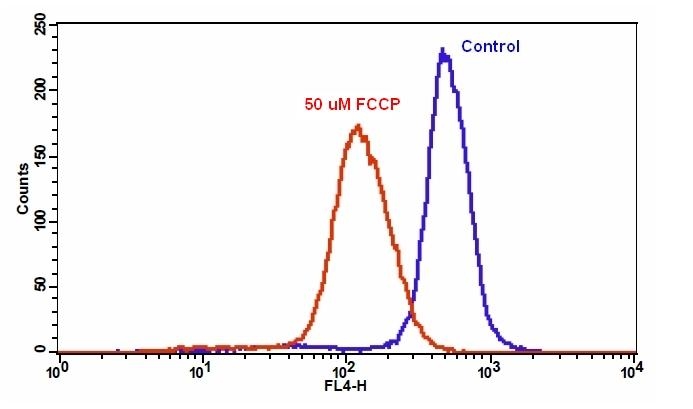Cell Meter™ NIR Mitochondrion Membrane Potential Assay Kit
Optimized for Flow Cytometry
Our Cell Meter™ assay kits are a set of tools for monitoring cell viability. There are a variety of parameters that can be used for monitoring cell viability. This particular kit is designed to monitor cell apoptosis through measuring the loss of the mitochondrial membrane potential. The collapse of mitochondrial membrane potential coincides with the opening of the mitochondrial permeability transition pores, leading to the release of cytochrome C into the cytosol, which in turn triggers other downstream events in the apoptotic cascade. Our Cell Meter™ NIR Membrane Potential Detection Kit provides all the essential components with an optimized assay method for the detection of apoptosis in cells with the loss of mitochondrial membrane potential. This fluorometric assay is based on the detection of the mitochondrial membrane potential in cells by our proprietary cationic MitoLite NIR™ dye. In normal cells, MitoLite NIR™ accumulates primarily in mitochondria, however, in apoptotic cells, MitoLite NIR™ staining intensity decreases. Cells stained with MitoLite NIR™ can be visualized by flow cytometry with red excitation and far red emission (FL4 channel). The kit can be paired with other reagents, such as blue-excited propidium iodide and Cell Meter™ Phosphatidylserine Apoptosis Assay Kit (#22831) for multi-parametric study of cell vitality and apoptosis. The kit is optimized for screening of apoptosis activators and inhibitors by flow cytometry.


| Catalog | Size | Price | Quantity |
|---|---|---|---|
| 22802 | 100 Tests | Price |
Spectral properties
| Excitation (nm) | 640 |
| Emission (nm) | 657 |
Storage, safety and handling
| H-phrase | H303, H313, H333 |
| Hazard symbol | XN |
| Intended use | Research Use Only (RUO) |
| R-phrase | R20, R21, R22 |
| UNSPSC | 12352200 |
Instrument settings
| Flow cytometer | |
| Excitation | 640 nm laser |
| Emission | 660/20 nm filter |
| Instrument specification(s) | APC channel |
Documents
Contact us
| Telephone | |
| Fax | |
| sales@aatbio.com | |
| International | See distributors |
| Bulk request | Inquire |
| Custom size | Inquire |
| Technical Support | Contact us |
| Request quotation | Request |
| Purchase order | Send to sales@aatbio.com |
| Shipping | Standard overnight for United States, inquire for international |
Page updated on December 17, 2025

